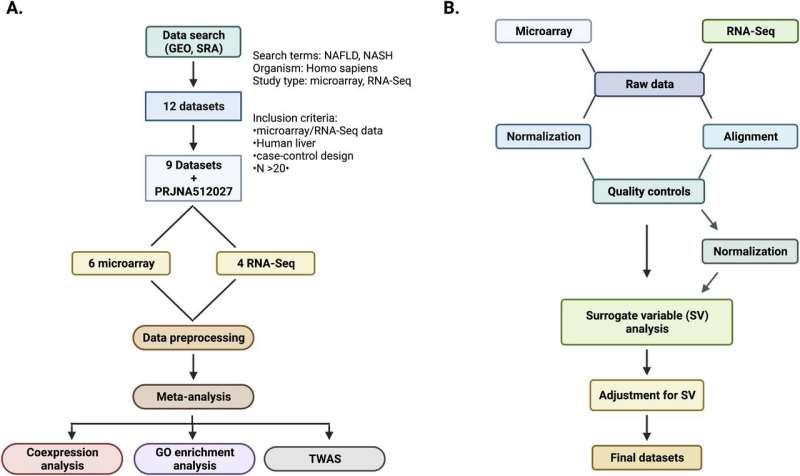This article has been reviewed according to Science X's editorial process and policies. Editors have highlighted the following attributes while ensuring the content's credibility:
fact-checked
trusted source
proofread
Study reveals genetic drivers of metabolic dysfunction-associated steatotic liver disease

In the largest study of its kind, researchers from the Translational Genomics Research Institute (TGen), part of City of Hope, have identified genes that appear to drive the progression of metabolic dysfunction-associated steatotic liver disease (MASLD) and metabolic dysfunction-associated steatohepatitis (MASH).
Formerly known as non-alcoholic fatty liver disease, MASLD affects about 30% of the global population, a number that is expected to nearly double by 2040. People with MASH, the more severe form of the disease, have a greater risk of deadly and disabling conditions such as fibrosis, cirrhosis, and hepatocellular carcinoma.
The absence of pharmacological interventions for MASH until the recent FDA approval in March 2024 underscores the urgent need addressed by this research.
In their report published April 2 in Life Science Alliance TGen researchers Johanna K. DiStefano, Ph.D., and Ignazio S. Piras, Ph.D., analyzed liver gene expression datasets derived from ten diverse cohorts comprising 1,058 patients and controls to find out more about the molecular drivers of MASLD. Their meta-analysis is the largest study of gene expression from liver biopsies to date, comparing more than 12,000 shared genes across the datasets.
Combining data from different datasets allowed the researchers to obtain a more robust perspective of gene expression patterns from the individual studies alone, which are more prone to false positive and negative results, explained Piras.
"Given the complex nature of MASLD, which is influenced by diverse genetic, lifestyle, demographic, and environmental factors, we would expect many genes across a number of different pathways to be involved," said DiStefano, Professor and Head of the TGen Diabetes and Fibrotic Disease Unit. "However, our investigation is the first to look at drivers of this disease progression from this unique perspective."
Among their findings, the scientists identified two different networks of genes co-expressed in the liver disease—one comprised of genes that were already known to be involved in MASLD, but also a second network of genes that had never been linked to the disease.
"Based on our rigorous statistical analysis, these are genes that are great candidates for driving disease progression," said DiStefano, "and they highlight promising candidates for targeted interventions, opening the door for the development of new treatments to prevent MASH," she added.
The researchers also found different gene expression patterns in MASLD and MASH. The differences between the two conditions were even larger than those between MASLD or MASH and healthy liver tissue.
"Some of those genes may exhibit differential expression due to the compromised function of the liver in MASH compared to MASLD," DiStefano explained. "Additionally, these genes could be specifically activated, contributing directly to the development of MASH."
Not everyone with MASLD progresses to MASH, although predictors include conditions such as excess adiposity, type 2 diabetes and metabolic syndrome.
Learning more about the genetic mechanisms underlying disease progression could help clinicians better predict which patients might be more likely to develop MASH, Piras noted.
More information: Ignazio S Piras et al, Comprehensive meta-analysis reveals distinct gene expression signatures of MASLD progression, Life Science Alliance (2024). DOI: 10.26508/lsa.202302517





















